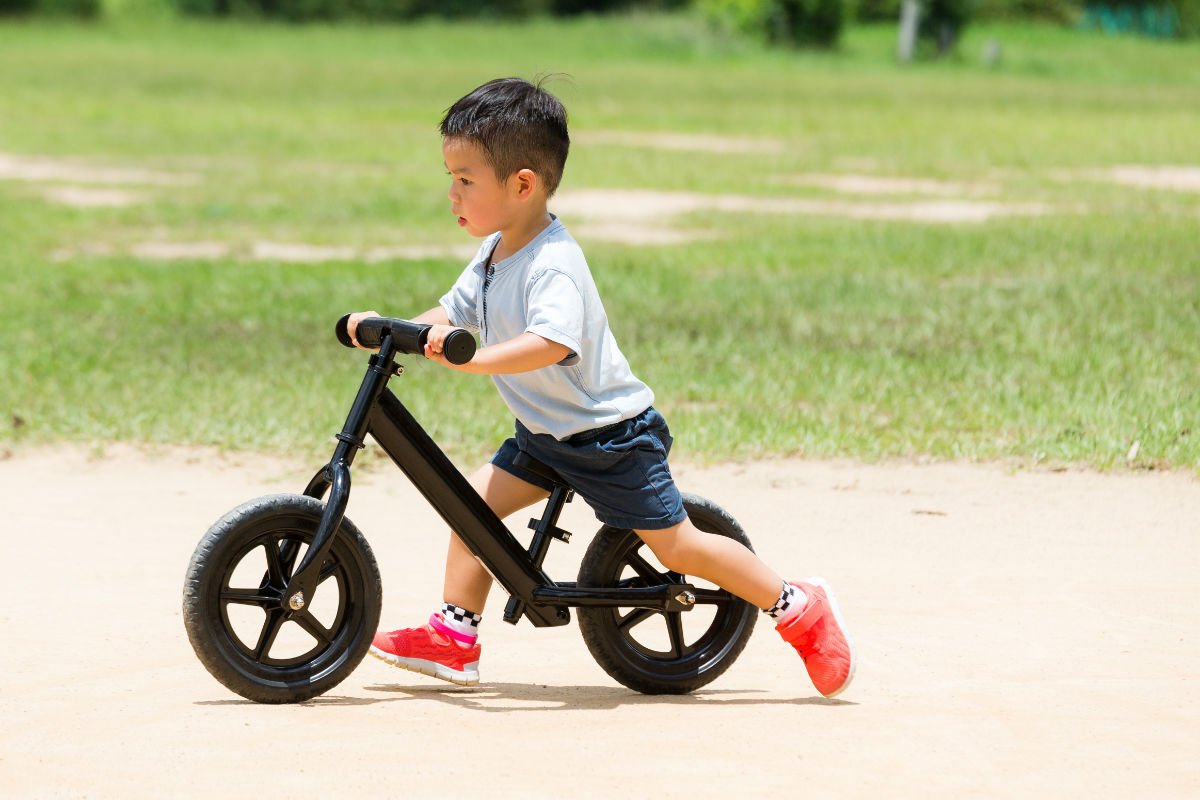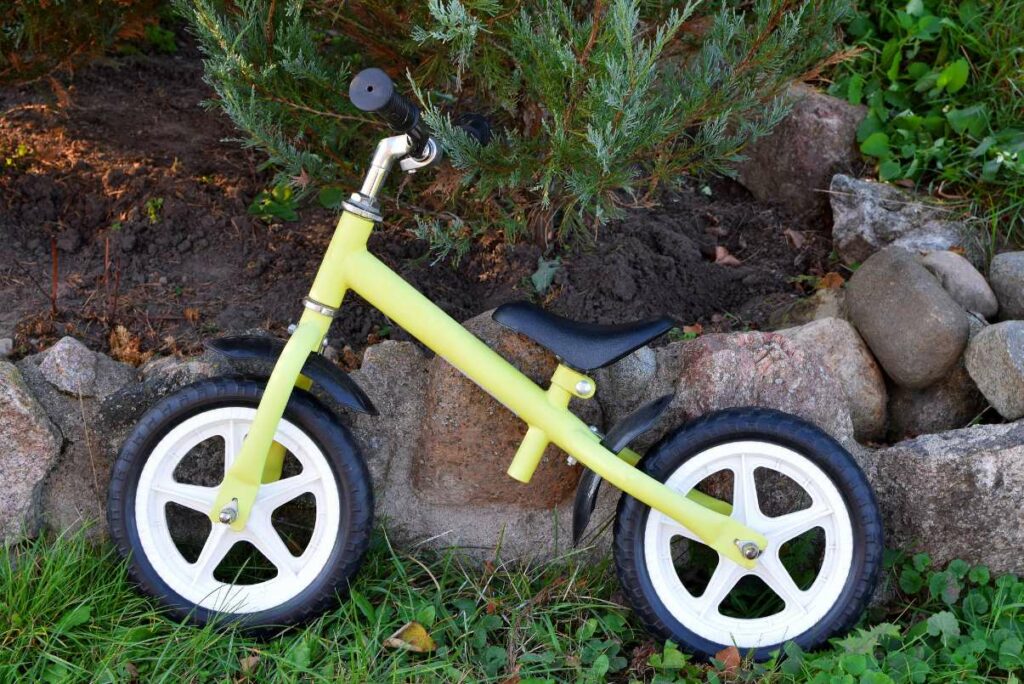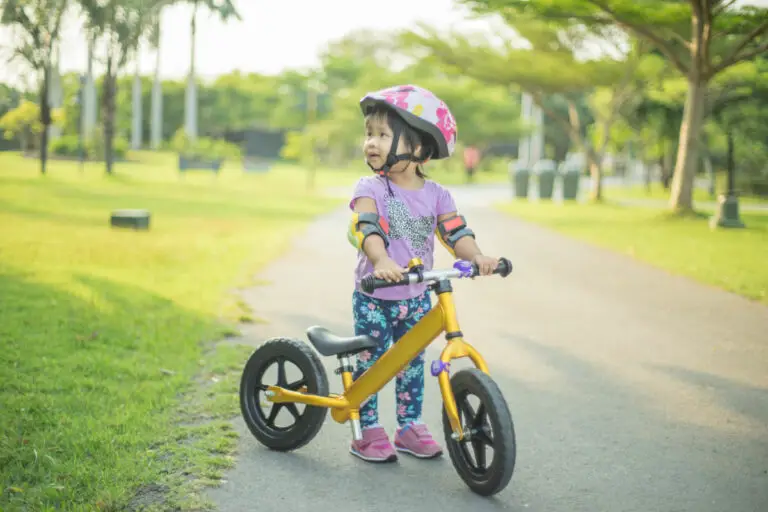What Is A Balance Bike Or Strider Bike?

A balance bike, also known as a push bike or Strider bike, is a form of bicycle developed for young children and novice riders.
Balance bikes, unlike standard bicycles, lack pedals and are designed to be powered by the rider’s feet.
This allows riders to concentrate on acquiring balance and steering rather than pedaling and movement coordination.
This article will examine the numerous elements of balance bikes, including how they function, their advantages and disadvantages, and how to select and maintain one.

How Balance Bikes Work
Typically, balance bikes have a low profile and wide, durable wheels to offer young riders stability and support. The bikes are propelled by the feet of the rider, who pushes off the ground to advance.
This enables riders to learn good balance and steering methods without the added complication of pedaling and coordinating movement.
Typically, balance bikes are available in two distinct styles: those with a regular bike frame and handlebars and those with a frame and handlebars resembling a scooter.
Both approaches are good for teaching riders balance and how to ride, and the ideal decision will depend on the tastes and demands of the individual rider.
Age Range for Balance Bikes
Balance bikes are typically best suited for very young children or beginners who are just learning to ride. Children as young as 18 months old can typically start using a balance bike, and the bikes are typically suitable for riders up to about age 5 or 6.
Once a rider becomes more confident and proficient, they may outgrow a balance bike and be ready to move on to a traditional bicycle with pedals.
Where to Buy Balance Bikes
Balance bikes are available at a range of retail establishments, such as bike shops, athletic goods stores, and internet merchants.
It is essential to browse around and compare pricing and features in order to discover the balance bike that best suits your demands and budget.
It is vital to examine the bike’s size and weight, the quality and longevity of the frame and wheels, and the adjustability of the seat and handlebars while searching for a balancing bike.
Balance bikes are usually associated with Strider, as they are the top brand in this space.
Pros of Balance Bikes
Young riders and novices who are learning to ride can benefit from balance bikes in several ways. Among the main benefits are:
- Ease of use: Balance bikes are extremely user-friendly, even for very young children who may lack the coordination or strength to pedal a conventional bicycle. As there are no pedals on balancing bikes, users may simply propel themselves forward with their feet and concentrate on learning to balance and steer.
- Safe and stable: Thanks to their low profile and broad, strong wheels, balance bikes are often quite secure and stable. This can provide young and novice riders with a sense of security and confidence as they learn to ride.
- Encourages proper riding technique: Balance bikes do not have pedals, therefore riders must learn how to balance and steer using the correct riding technique. This can assist riders to build excellent habits and skills that can be transferred to conventional bicycles once they are ready to pedal.
- Lightweight: Balance bikes are often significantly lighter than conventional bicycles, making them easier to manage and maneuver for young riders. This is especially beneficial for younger riders who may have trouble controlling a bigger bike.
Cons of Balance Bikes
While balance bikes can be a useful tool for learning how to ride a bicycle, there are certain disadvantages to consider.
- Limited use: Balance bikes are often only appropriate for extremely small children or novice riders just learning to ride. Once a rider develops greater confidence and skill, they may outgrow a balance bike and require a conventional bicycle with pedals.
- Slower speed: Due to the lack of pedals, riders of balancing bikes must rely on their own power and momentum to push the bike. This can make balancing bikes slower than conventional bicycles, which can frustrate riders who desire a bit more speed.
- Limited terrain: The lack of pedals on a balancing bike makes it difficult for riders to maintain balance and motion on rough or uneven terrain. This can restrict the types of terrain balance bike riders can explore.

Choosing a Balance Bike
It is vital to consider the rider’s age and size, the bike’s weight and durability, and the adjustability of the seat and handlebars while selecting a balancing bike. Here are a few additional important considerations:
- Frame and wheels: Look for a bicycle with a solid, long-lasting frame and broad, durable wheels to provide stability and support. Avoid bicycles with small or flimsy wheels, as they may be unstable or prone to tipping.
- Adjustability: Choose a bicycle with an adjustable seat and handlebars to provide a comfortable fit for the user. This can help assure the rider’s comfort and ability to reach the ground when seated on the bike.
- Weight: Consider the weight of the bicycle, since a lighter bike may be easier for the user to control and maneuver. This is especially crucial for smaller or younger riders who may struggle to maneuver a heavy bike.
Maintaining a Balance Bike
To ensure that a balance bike is functioning effectively and providing essential support and stability for the user, proper maintenance is required. Here are a few maintenance guidelines for a balancing bike:
- Regularly check the bike: It is essential to check the bicycle frequently to ensure that all parts are functioning properly and are securely fastened. Wheels, frame, and handlebars are the most critical components for stability and safety, therefore pay special attention to them.
- Inspect the bike for wear: Balance bikes can deteriorate over time, especially if they are often used or on difficult terrain. Regularly inspecting the bicycle for signs of wear, such as cracks or chips in the plastic or metal, is essential. The bicycle should be repaired or replaced if it is broken or worn.
- Lubricate the bike: Balance bikes should be greased on a regular basis to ensure that all moving parts are free of binding and sticking. This can assist prolong the life of the bicycle and guarantee that it provides the required support and stability for the user.
In conclusion, Balance bikes are a wonderful tool for teaching young children and beginners how to balance and ride a bicycle.
Young riders who are just learning to ride may find balancing bikes to be an excellent option due to their user-friendliness, safety, and ability to promote good riding technique.
However, it is essential to select a high-quality, long-lasting bicycle that is appropriately sized and fitted for the user, and to perform routine maintenance to ensure the bike is in good operating condition.



